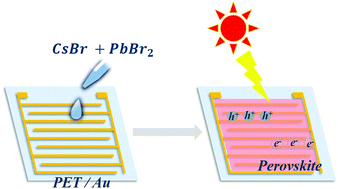Low-temperature processed inorganic perovskites for flexible detectors with a broadband photoresponse†
Abstract
Flexible photodetectors (PDs) have become a research hotspot due to their potential applications in foldable displays, wearable optoelectronic devices, and implantable biomedical sensors. Inorganic CsPbBr3 perovskites, an emerging class of stable metal halide perovskites, have been explored as photoactive materials in PDs due to their superior photoelectrical properties and simple processing. The reported temperature for the fabrication of high-quality CsPbBr3 films is usually higher than 150 °C, which hinders their application in flexible devices. Here, for the first time, high-performance flexible PDs based on CsPbBr3 perovskite films, which showed a broadband spectrum response from blind ultraviolet to visible light, were realized via a modified low-temperature (70 °C) solution-processed method. The perovskite films prepared by this method exhibited improved morphology and high light-harvesting capability. The device also yielded high ON/OFF ratio (103), fast response speed (260 ms, rise time) and high responsivity (0.24 mA W−1) for solar-blind UV light (254 nm) at 2 V. Moreover, the photodetector exhibited outstanding mechanical flexibility and long-term environmental stability for two months without encapsulation. Our work paves the way for the realization of cost-efficient high-performance flexible optoelectronic devices.



 Please wait while we load your content...
Please wait while we load your content...